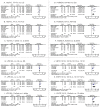A systematic review and meta-analysis of the association between serotonergic gene polymorphisms and obstructive sleep apnea syndrome
- PMID: 24475124
- PMCID: PMC3903532
- DOI: 10.1371/journal.pone.0086460
A systematic review and meta-analysis of the association between serotonergic gene polymorphisms and obstructive sleep apnea syndrome
Abstract
Background: 5-Hydroxytryptamine receptor (5-HTR) and 5-hydroxytryptamine transporter (5-HTT) gene polymorphisms have been reported to be associated with susceptibility to obstructive sleep apnea syndrome (OSAS). The associations, derived from sporadic, inconsistent, small-sample-size studies, need to be evaluated further in a meta-analysis.
Methods: Relevant studies were identified by searching PubMed, Embase, The Cochrane Library, China National Knowledge Infrastructure (CNKI), Wanfang, and Weipu. Eligible data were extracted from each included study. Odds ratios (ORs) were calculated using a fixed-effects or a random-effects model. The ORs and 95% confidence interval (CI) were used to assess the strength of the association between serotonergic gene polymorphisms and OSAS in the dominant and recessive models, as well as alleles. The Q statistic was used to evaluate homogeneity and Begg's test was used to assess publication bias.
Results: Eight studies were finally included in the meta-analysis of the association between 5-HTR2A gene variants (including 102T/C and 1438G/A), 5-HTT gene polymorphisms (including 5-HTT gene-linked promoter region (5-HTTLRP), and serotonin transporter intron 2 variable number tandem repeat (STin2VNTR) and OSAS risk. The G allele of 5-HTR2A 1438G/A, long 5-HTTLPR, and 10-tandem-repeats STin2VNTR were shown to increase OSAS susceptibility, with ORs of 2.33 (A vs. G, 95% CI 1.48-3.66), 1.24 (L vs. S, 95% CI: 1.04-1.49), and 2.87 (10 vs. 12, 95% CI: 1.38-5.97), respectively. These significant differences were determined in both dominant and recessive models. Of the 5-HTR2A 1438G/A gene polymorphism, the AA genotype increased the OSAS risk, with an OR of 4.21 (95% CI: 2.83-6.25) in a recessive model in male OSAS patients, but no significant association was found in females.
Conclusions: Our meta-analysis demonstrated that polymorphisms in the 5-HTR2A 1438G/A and 5-HTT genes contributed to susceptibility to OSAS. The A allele of the 1438G/A gene polymorphism is predominantly distributed in males and increased the OSAS risk significantly.
Conflict of interest statement
Figures



Similar articles
-
The association of 5-HT2A, 5-HTT, and LEPR polymorphisms with obstructive sleep apnea syndrome: a systematic review and meta-analysis.PLoS One. 2014 Apr 22;9(4):e95856. doi: 10.1371/journal.pone.0095856. eCollection 2014. PLoS One. 2014. PMID: 24755731 Free PMC article.
-
Association between 5-HT2A receptor polymorphisms and risk of obstructive sleep apnea and hypopnea syndrome: a systematic review and meta-analysis.Gene. 2013 Nov 10;530(2):287-94. doi: 10.1016/j.gene.2013.08.012. Epub 2013 Aug 26. Gene. 2013. PMID: 23988500
-
Association of 5-HTT gene polymorphisms with migraine: a systematic review and meta-analysis.J Neurol Sci. 2011 Jun 15;305(1-2):57-66. doi: 10.1016/j.jns.2011.03.016. Epub 2011 Mar 30. J Neurol Sci. 2011. PMID: 21450309
-
Candidate gene studies of fibromyalgia: a systematic review and meta-analysis.Rheumatol Int. 2012 Feb;32(2):417-26. doi: 10.1007/s00296-010-1678-9. Epub 2010 Dec 1. Rheumatol Int. 2012. PMID: 21120487
-
Platelet glycoprotein gene Ia C807T, HPA-3, and Ibα VNTR polymorphisms are associated with increased ischemic stroke risk: Evidence from a comprehensive meta-analysis.Int J Stroke. 2017 Jan;12(1):46-70. doi: 10.1177/1747493016672085. Epub 2016 Oct 22. Int J Stroke. 2017. PMID: 28004990
Cited by
-
Sleep as a Target for Optimized Response to Smoking Cessation Treatment.Nicotine Tob Res. 2019 Jan 4;21(2):139-148. doi: 10.1093/ntr/ntx236. Nicotine Tob Res. 2019. PMID: 29069464 Free PMC article. Review.
-
Anatomical landmarks for the localization of the greater palatine foramen--a study of 1200 head CTs, 150 dry skulls, systematic review of literature and meta-analysis.J Anat. 2014 Oct;225(4):419-35. doi: 10.1111/joa.12221. Epub 2014 Aug 5. J Anat. 2014. PMID: 25131842 Free PMC article.
-
Admixture mapping identifies novel loci for obstructive sleep apnea in Hispanic/Latino Americans.Hum Mol Genet. 2019 Feb 15;28(4):675-687. doi: 10.1093/hmg/ddy387. Hum Mol Genet. 2019. PMID: 30403821 Free PMC article.
-
Variants in angiopoietin-2 (ANGPT2) contribute to variation in nocturnal oxyhaemoglobin saturation level.Hum Mol Genet. 2016 Dec 1;25(23):5244-5253. doi: 10.1093/hmg/ddw324. Hum Mol Genet. 2016. PMID: 27798093 Free PMC article.
-
Nutrigenetic genotyping study in relation to Sleep Apnea Clinical Score.Sleep Breath. 2019 Jun;23(2):659-663. doi: 10.1007/s11325-018-1742-3. Epub 2018 Oct 17. Sleep Breath. 2019. PMID: 30334133
References
-
- Young T, Palta M, Dempsey J, Skatrud J, Weber S, et al. (1993) The occurrence of sleep-disordered breathing among middle-aged adults. N Engl J Med 328: 1230–1235. - PubMed
-
- Saudou F, Hen R (1994) 5-Hydroxytryptamine receptor subtypes in vertebrates and invertebrates. Neurochem Int 25: 503–32. - PubMed
Publication types
MeSH terms
Substances
LinkOut - more resources
Full Text Sources
Other Literature Sources
Medical

